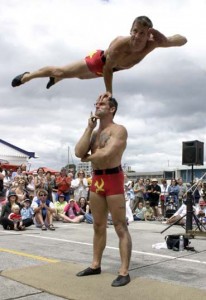
Popeyed - seriously cool circus balancing
Both gorilla sweeps and ninja sweeps are applied when your opponent is supporting his own weight. When your opponent’s weight is supported by you, it is time to consider circus sweeps.
The mental image for a circus sweep is the circus act where one performer is balancing on top of another performer. The top person’s ability to stay on top depends upon his balance and the degree to which the bottom person makes a stable platform.
The idea behind circus sweeps is simple. Make yourself into an unstable platform so your opponent loses balance and falls. There are two cases to consider; your opponent has more weight on you and less on the ground, and the converse when less weight is on you and more is on the ground.
Most weight on you: When your opponent has most of his weight on you, you can easily sweep him by removing any of his potential posts and rolling your body. If your opponent stays connected to your body he will fall. The key point to remember is to keep his weight on you and don’t allow your opponent to shift his weight back to the ground.
Here is an example of this type of sweep in competition. Collapsing the opponent’s elbow removes his post and allows the roll to take him over.
Most weight on the ground: You need to get yourself under your opponent to perform a circus sweep when your opponent has most of his weight on the ground but has some weight on you. Applying upwards pressure when under your opponent is an effective way to off balance him. Most x-guard, deep butterfly halfguard and inverted guard sweeps use the principle of upwards pressure when under your opponent.
Christian Graugart made a good post with a detailed video on deep butterfly halfguard a few months ago. Check it out. Christian covers getting under your opponent and applying the upwards pressure needed to sweep.
